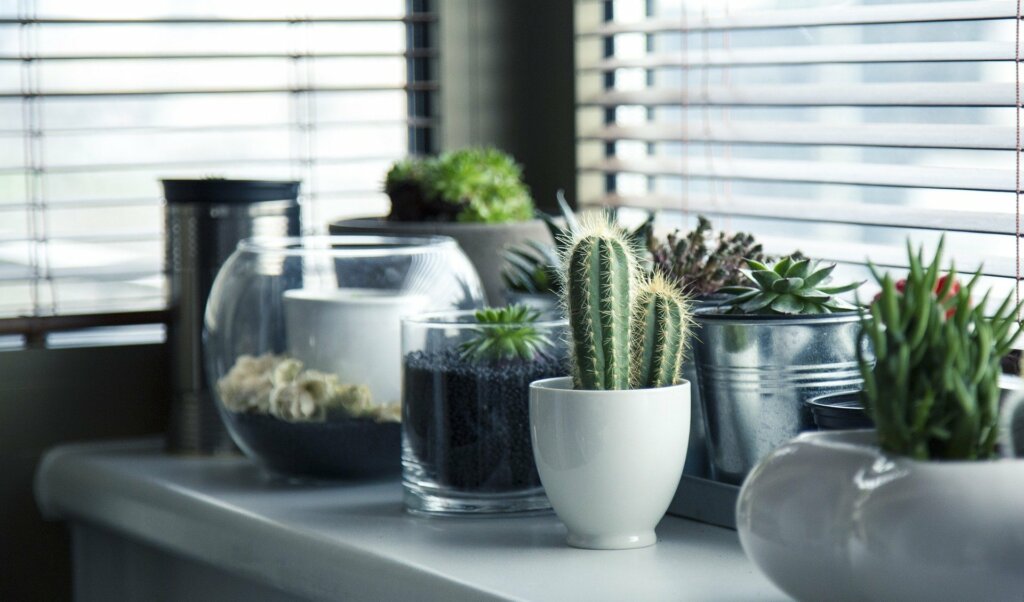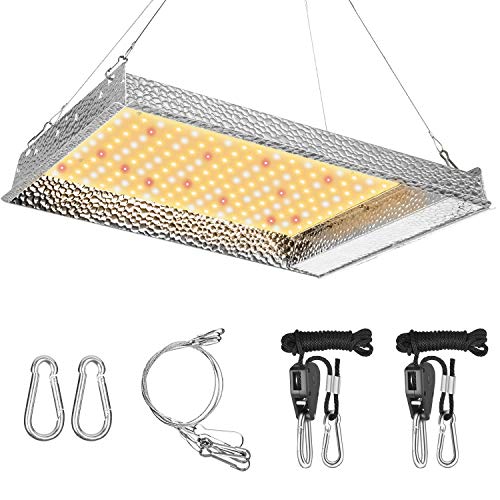Growing plants indoors has become more trendy. Plants will not grow properly under an insufficient light spectrum, whether in your house or garden. Moreover, most winter-based countries find it difficult to cultivate plants. As a result, it is essential to understand the grow lights for plants.
While the weaker light of the season may be enough for some houseplants, others may require a boost to maintain the growth. Others, such as flowering plants and garden seedlings, may require more intense light than your home can provide.
If you’re anxious that your plants aren’t absorbing the nutrients they need to grow; you’ll surely need to find a remedy. LED grow lights for plants are the most acceptable option for growing your plants indoors in this situation.
However, if you intend to install some grow lights for plants in your home, this article will assist you to the finish. Please take the time to go through this complete guide, and you will learn enough about growing lights for plants.
How much light do my indoor plants need?
Plants require light the way animals need food. This light or food converts into the energy that supports growth, reproduction, and living. And when it comes to our indoor plants, it isn’t easy to understand which plants require how much light. A houseplant that receives too much or too little light can get distressed and eventually die.
Therefore, the strength of the light varies depending on the type of plant. Foliage plants require around 14-16 hours of light every day. On the other side, blooming plants require 12-16 hours of light every day.
Darkness is also necessary for plant development, providing your plants at least 8 hours of absolute darkness a day. Usually, we can group these indoor plants into three primary types. In the following, check out the examples for each light intensity.

- High-light indoor plants need direct sunlight and long exposure. Croton plant care, Ming Aralia Plant, Schefflera Arboricola – Dwarf Umbrella Tree, Araucaria Plant – Norfolk Island Pine, Ponytail Palm Tree, Columnar Cereus peruvianus cactus, Yucca Plant, Ficus Benjamina, White Bird of Paradise, etc. are the most famous example for this type.
- Medium-light indoor plants need partial, filtered, or indirect sunlight. Bamboo palm plant (Chamaedora seifrizii), Marble queen pothos, Rhapis palm, Kentia palm, Spathiphyllum, Dracaena Janet Craig plant, Warneckii, and Marginata, Neanthe Bella, Aglaonema B.J. Freeman & Cecelia are the common examples of this kind.
- Low-light indoor plants need minimal natural light or artificial light. Aspidistra Elatior, Aglaonema, Dracaena Massangeana, Dracaena Deremensis, Lucky Bamboo, Sansevieria, ZZ plant, Hedera Helix, or English Ivy, Peace Lily are the most common example of this kind. No sunlight in your space will also be suitable for these plants.
Growing Light Basics
Choosing the appropriate growing lights spectrum for your plants may be tricky. Many LED growing lights suppliers have conflicting information on the problem due to improper marketing or a lack of understanding in plant and light research.
Therefore, it is essential to understand the basics of growing lights technology. You need to understand three basic terms for indoor plants: light spectrum, color temperature, and light intensity.
Light spectrum
A light source’s light spectrum is the range of wavelengths it produces. From 380 to 740 nanometers, light is the visible wavelengths of the electromagnetic spectrum that humans can perceive (nm). Radiation is the wavelengths in the ultraviolet (100–400 nm), far-red (700–850 nm), and infrared (700–106 nm) ranges.
Plants detect UV light (260–380 nm), while the visible section of the spectrum (380–740 nm) supplies PAR (400–700 nm) and far-red radiation (700–850 nm).
Color temperature
The color temperature of the light generated by the growing lights for plants specifies the color of the light. The suitable color temperature range for plants is 1,000 (warm/red) to 10,000 (cool/blue). However, the unit of this measurement is Kelvin (K).
Color influences plant development in a variety of ways. Red light stimulates flowering and fruit development, whereas blue light is necessary for vegetative growth. The color temperature of grow lights for plants might assist you in figuring out if the light’s overall output is blue or red.
Light intensity
Light intensity influences plant food production, stem length, leaf color, and blooming. Plants cultivated in low light are often spindly and have pale green leaves. A comparable plant with intense light has shorter stems, better branches, and bigger, dark green leaves.
| Light Intensity (LUX) | Description |
| 200-500 | Low light intensity and deep shade usually Not ideal for most plants |
| 500-1,000 | Lower light intensity yet bright enough to read. This light intensity is excellent for shade-loving plants. It reflects the natural light of a standard room. |
| 1,000 – 2,000 | Bright but oblique sunlight makes a definite shadow, appropriate for plants that demand indirect sunlight. |
| 2,000 – 4,000 | This light intensity is about 40% of the midday sun, and direct light from windows is bright. It’s perfect for a wide range of plants that demand a steady amount of light. |
| 4,000 – 5,000 | This light intensity is around 50% of the midday sun and has intense direct sunlight. Plants that demand a lot of bright light should use this. |
| >5,000 | Very bright indoor light but still not as strong as outdoor sunlight |
Grow light types
Indoor plants improve under full-spectrum bulbs, which produce cold and warm light that replicates the natural solar light spectrum, just as they do in the sun. Using the best grow lights for plants to create a natural environment inside.
However, we will discuss the most common growing lights available in the following.
LED grow lights
Compared to other lighting types, LED showed up later. LEDs quickly demonstrate their value by functioning well and offering distinct benefits over different kinds of grow lights for plants.
Led grow hobbyists and professional greenhouse farms commonly use LED grow lights for plants. LEDs are energy-efficient, emit little heat, and need less maintenance. Furthermore, you can also customize these LEDs to emit a specified light wavelength.
HPS grow lights
Half of a normal HID (high-intensity discharge) grow system are high-pressure sodium (HPS) grow lights. HPS grow lights for plants provide a red spectrum light suitable to replace MH (metal halide) bulbs after your plants have reached the flowering stage.
HPS plant grow lights for indoor plants have been a famous option for growers for over 50 years since they are economical and handy for farmers of all skill levels.
HID grow lights
Plants that need greater light intensities than fluorescent lightings, such as cereal, forage, citrus, and C4 plants, have used high-intensity discharge (HID) grow lights for indoor plants. In regulated conditions such as labs or indoor farms, HID grow lights for plants are popular.
Fluorescent grow lights
Fluorescent grow lights for plants transform electrical energy into light by passing a current through mercury vapor, which generates UV radiation, which causes the phosphor powder coating on the lamp’s interior to glow, resulting in visible light.
The chemical makeup of the phosphor determines the hue of light.
Halogen grow lights
Although halogen lights are not ideal for growing plants, they will provide results. Halogen lights are 25 to 30% brighter than traditional incandescent lighting. They last 2,000 hours and remain brighter for longer.
They are not great for growing plants since they offer a lot of light from the red end of the spectrum but not much light from the blue end. The brightness of the light is slow. However, plants will grow under halogen lights with natural or artificial light supplementation.
Ceramic metal halide grow light
Ceramic Metal Halide grow lights for plants combine MH and HPS grow lights. Instead of the quartz used in standard metal halide grow lights, a CMH employs a ceramic arc tube similar to those used in HPS grow lights.
CMH lights consume 20% less energy than incandescent light bulbs to provide the same amount of light—80 to 117 lumens per watt. The savings apply regardless of wattage, so you’ll save whether you’re using a 315w CMH grow light, a 630w CMH CMH, or a 1,000w CMH bulb.
Best grow lights on Amazon
We looked at the best grow lights for indoor plants on Amazon, weighing them on their ease of use, efficiency, brightness, and overall efficacy. Our Best options are as follows:
Best led grow light for the money.
Miracle LED Plant Grow Lights, 100W Spectrum best grow lights for indoor plants, best LED grow lights for money
$29.17
Our Best led grow light for the money is 100W Miracle LED grow light. This excellent led grow light for plants provides Daylight white full spectrum for any DIY horticulture projects.
The customer review of this item is extraordinary. Only $20 can get you a double pack of this item. These LED grow lights for plants run for $1.08 per year with virtually no heat signature.
Best 600W LED plant grow lights
iPower Plant Lights for Indoor Growing and garden, 600W LED best grow lights for indoor plants
iPower 600W is our best pick for 600W LED grow light. These LED grow lights for plants simulated natural sunshine, including white (3000K), blue (6000K), red (660nm), and infrared (IR) wavelengths (730nm). The 660nm red and infrared light is particularly beneficial during bloom since it accelerates flowering and increases yields.
iPower 600 provides increased light intensity, less light fade, better lumens, and PAR values than regular lamp beads.
Best t5 led plant grow lights
Active Grow Plant Grow Lights, 4FT LED grow lights for plants
You’ve come to the right place if you’re looking for a T5 LED grow light. T5 High Output 4FT LED Grow Light is available from Active Grow Light Store for any horticultural project. This item may save you up to 50% on your lighting and HVAC bills by replacing T5 HO 54W fluorescent lights.
Finally, these lights have a 30,000-hour lifespan and a one-year guarantee. Furthermore, the producer did not compromise the product’s quality and efficacy.
Best Double Ended Grow Lights
VIVOSUN best grow lights for Indoor Plants, Double Ended HPS grow lights for plants
We’ve come up with our top Amazon option for a Double-ended grow lamp. The VIVOSUN 2 Pack of 1000W Double Ended High-Pressure Sodium DE HPS Grow Bulb produces a concentrated, targeted light spectrum.
This outstanding double-ended grow light emits the most significant quality light evenly and without blockage, and it lasts almost twice as long as a single-ended bulb.




